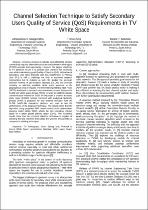 ResearchSpace
ResearchSpace
Channel selection technique to satisfy secondary users quality of service (QoS) requirements in TV white space
JavaScript is disabled for your browser. Some features of this site may not work without it.
- ResearchSpace
- →
- Research Publications/Outputs
- →
- Conference Publications
- →
- View Item
| dc.contributor.author |
Makgamatha, AS

|
|
| dc.contributor.author |
Zuva, T

|
|
| dc.contributor.author |
Masonta, Moshe T

|
|
| dc.date.accessioned | 2018-10-15T12:23:51Z | |
| dc.date.available | 2018-10-15T12:23:51Z | |
| dc.date.issued | 2018-08 | |
| dc.identifier.citation | Makgamatha, A.S., Zuva, T. and Masonta, M.T. 2018. Channel selection technique to satisfy secondary users quality of service (QoS) requirements in TV white space. International Conference on Advances in Big Data, Computing and Data Communication Systems (icABCD 2018), 6-7 August 2018, Durban, South Africa | en_US |
| dc.identifier.uri | http://hdl.handle.net/10204/10466 | |
| dc.description | Paper presented at the International Conference on Advances in Big Data, Computing and Data Communication Systems (icABCD 2018), 6-7 August 2018, Durban, South Africa. This is the accepted version of the paper. | en_US |
| dc.description.abstract | Growing demand of reliable and affordable wireless connectivity requires alternative solutions and television white space (TVWS) provides that opportunity. However, the biggest challenge in TV spectrum re-use is to allocate best channels for secondary user while maintaining good Quality of Service (QoS). Allocation of Secondary User (SU) channels with less interference to Primary User (PU) is still a challenge not only to academia research communities but to industry as well. We studied the spectrum selection method of geo-location database (GLDB) that provides certainty in selecting available white space spectrum in the geographical area of request. The Internet Engineering Task Force (IETF) developed a standard communication protocol between the GLDB and white space devices (WSD) in order to establish reliable communication method for WSD. In this paper, a protocol to access white space (PAWS) method combined with analytical hierarchy process (AHP) is proposed for best channel selection from the GLDB. MATLAB simulation platform was used to test the performance of the proposed technique. The results show that the algorithm using proposed AHP based method (with deterministic queuing model within WSD) selects the best operating channel based on a better global priority vector (GPV). The numerical results show that the proposed selection technique is capable of selecting the best channels that satisfy the QoS for SUs profiles as compared to existing techniques. | en_US |
| dc.language.iso | en | en_US |
| dc.relation.ispartofseries | Worklist;21403 | |
| dc.subject | TV Whitespace | en_US |
| dc.subject | Smart Set-top box | en_US |
| dc.subject | Protocol to Access White Space | en_US |
| dc.subject | Geo-location database | en_US |
| dc.subject | White space device | en_US |
| dc.subject | Base station | en_US |
| dc.title | Channel selection technique to satisfy secondary users quality of service (QoS) requirements in TV white space | en_US |
| dc.type | Conference Presentation | en_US |
| dc.identifier.apacitation | Makgamatha, A., Zuva, T., & Masonta, M. T. (2018). Channel selection technique to satisfy secondary users quality of service (QoS) requirements in TV white space. http://hdl.handle.net/10204/10466 | en_ZA |
| dc.identifier.chicagocitation | Makgamatha, AS, T Zuva, and Moshe T Masonta. "Channel selection technique to satisfy secondary users quality of service (QoS) requirements in TV white space." (2018): http://hdl.handle.net/10204/10466 | en_ZA |
| dc.identifier.vancouvercitation | Makgamatha A, Zuva T, Masonta MT, Channel selection technique to satisfy secondary users quality of service (QoS) requirements in TV white space; 2018. http://hdl.handle.net/10204/10466 . | en_ZA |
| dc.identifier.ris | TY - Conference Presentation AU - Makgamatha, AS AU - Zuva, T AU - Masonta, Moshe T AB - Growing demand of reliable and affordable wireless connectivity requires alternative solutions and television white space (TVWS) provides that opportunity. However, the biggest challenge in TV spectrum re-use is to allocate best channels for secondary user while maintaining good Quality of Service (QoS). Allocation of Secondary User (SU) channels with less interference to Primary User (PU) is still a challenge not only to academia research communities but to industry as well. We studied the spectrum selection method of geo-location database (GLDB) that provides certainty in selecting available white space spectrum in the geographical area of request. The Internet Engineering Task Force (IETF) developed a standard communication protocol between the GLDB and white space devices (WSD) in order to establish reliable communication method for WSD. In this paper, a protocol to access white space (PAWS) method combined with analytical hierarchy process (AHP) is proposed for best channel selection from the GLDB. MATLAB simulation platform was used to test the performance of the proposed technique. The results show that the algorithm using proposed AHP based method (with deterministic queuing model within WSD) selects the best operating channel based on a better global priority vector (GPV). The numerical results show that the proposed selection technique is capable of selecting the best channels that satisfy the QoS for SUs profiles as compared to existing techniques. DA - 2018-08 DB - ResearchSpace DP - CSIR KW - TV Whitespace KW - Smart Set-top box KW - Protocol to Access White Space KW - Geo-location database KW - White space device KW - Base station LK - https://researchspace.csir.co.za PY - 2018 T1 - Channel selection technique to satisfy secondary users quality of service (QoS) requirements in TV white space TI - Channel selection technique to satisfy secondary users quality of service (QoS) requirements in TV white space UR - http://hdl.handle.net/10204/10466 ER - | en_ZA |





